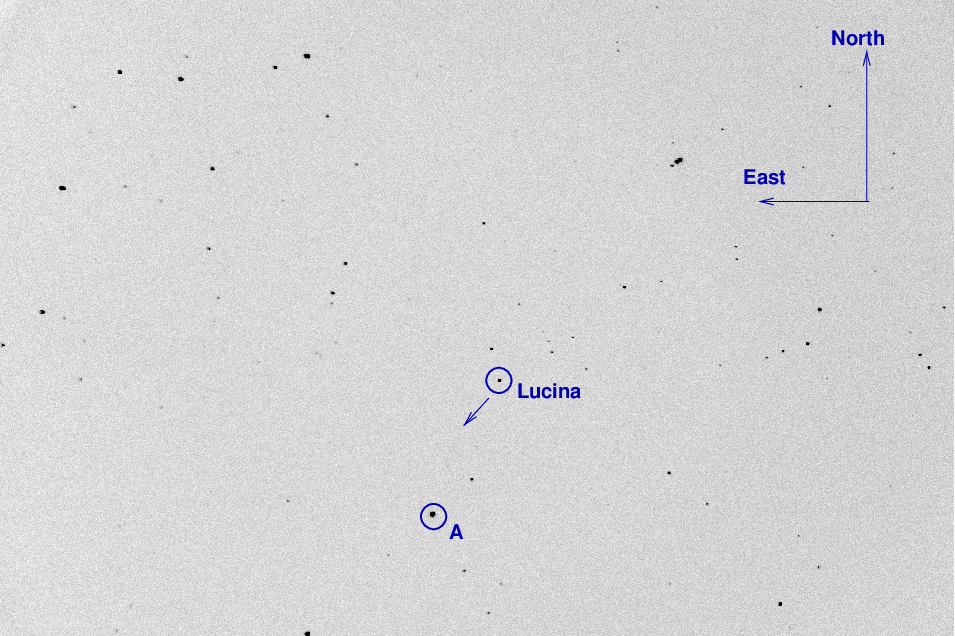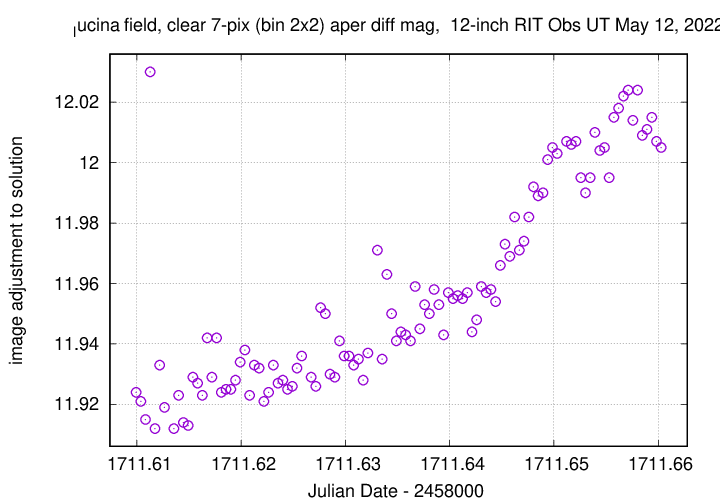
On the night of May 11/12, 2022, under good conditions, I did a bit of astrometry of the asteroid 146 Lucina, just for practice. It had been a few years since I'd submitted any measurements to the Minor Planet Center, and I wanted to go through the steps involved again just to refresh my memory.
On this same night, AST graduate student Lazar Buntic continued his tests of a new camera on the 14-inch telescope in our rolloff building. He took a good series of images of M67 through different filters, which will help him to characterize the instrument's performance.
Asteroid 146 Lucina is an ordinary main-belt asteroid. Its orbit is well known, so my measurements won't serve any real scientific purpose. I just wanted a bit of practice.
The Moon was just far enough to the East of the field that it did NOT shine in through the dome slit and onto the telescope. Phew.
The main setup was:
Notes from the night:
I took a long series of 30-second images of the field centered near
RA = 10:03:30 Dec = +27:12:32
Below is a chart of the field, which is about 41 x 27 arcminutes on a side. It shows Lucina, which was moving to the south-east at (25, -20) arcseconds per hour, roughly.

The bright star marked "A" is HD 87142, which has magnitude G = 10.40. I used it to shift the ensemble photometry to the Gaia G-band scale, in order to report an approximate magnitude to the MPC.
The sky showed no sign of any major clouds -- just a gradual brightening as the field set.

The FWHM remained steady during this short run.

The ensemble zero-point shows a smooth increase, again indicating little or no cloud.

Using aperture photometry with a radius of 7 pixels in the clear filter (binned 4x4, each pixel is 1.04 arcsec, so a radius of 7.28 arcsec), I measured the instrumental magnitudes of a number of reference stars and the target. Following the procedures outlined by Kent Honeycutt's article on inhomogeneous ensemble photometry, I used all stars available in each image to define a reference frame, and measured each star against this frame.
The photometric uncertainty rose from a floor of about 0.004 mag at the bright end.

I grabbed stars from the Gaia EDR3 catalog to serve as astrometric references, selecting stars brighter than G = 15 and within 15 arcminutes of the center of the field. There were 53 stars in this catalog set. I then ran the match program to find the transformation which would take the detected stars to the positions of the catalog stars. The best results occurred when I set the parameters
Decreasing the "trirad" value from its default of 0.002 caused twice as many frames to match the catalog; I'll have to remember that in the future.
The plate scale was 1.037 arcsecond per pixel, and the scatter from the solution was 0.12 arcsec in RA and 0.08 arcsec in Dec. Very nice.
I chose three good images from the run, measured the position of Lucina, and created a report for the MPC.
COD 920 CON M. Richmond, Physics Dept., RIT, Rochester, NY 14623 CON [mwrsps@rit.edu] OBS M. Richmond MEA M. Richmond TEL 0.30-m f/10 Schmidt-Cassegrain + CMOS NET Gaia EDR3 ACK measurements of 146 Lucina 146 B2022 05 12.11265 10 03 29.94 +27 12 38.8 13.0 G 920 146 B2022 05 12.13759 10 03 31.07 +27 12 26.2 13.0 G 920 146 B2022 05 12.14894 10 03 31.59 +27 12 20.4 13.0 G 920
Last modified 5/09/2022 by MWR.